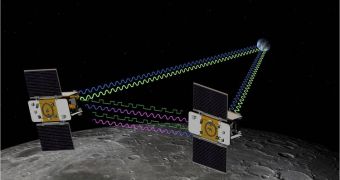According to officials at the American space agency, the two spacecraft making up the Gravity Recovery and Interior Laboratory (GRAIL) lunar mission will continue to conduct their scientific investigations until at least December 3.
Officially, the primary science mission lasted from March 1 to May 29, but flight controllers received the go-ahead to conduct an extended science phase, which is scheduled to run from August 30 to December 3. As such, the only instrument aboard the probes was turned on yesterday.
Each GRAIL spacecraft carries a Lunar Gravity Ranging System, whose purpose is to keep accurate track of the distance between the two orbiters. As they pass over areas of greater mass, changing gravitational pulls modify this distance.
By studying how it shifts, the probes can basically determine the composition of the lunar underground, identifying the locations that are more dense, and where more mass is crammed up. The spacecraft have been studying lunar gravity since they arrived there on December 31, 2011 and January 1, 2012.
A couple of days ago, on August 31, the LGRS was turned on on both spacecraft, as they were traveling above a lunar landscape feature called the Ocean of Storms, at an altitude of just 30 kilometers (19 miles). The maneuver took place at 9:28 am PDT (12:28 pm EDT/1628 GMT).
“The data collected during GRAIL's primary mission team are currently being analyzed and hold the promise of producing a gravity field map of extraordinary quality and resolution,” Maria Zuber says.
“Mapping at a substantially lower altitude during the extended mission, and getting an even more intimate glimpse of our nearest celestial neighbor, provides the unique opportunity to globally map the shallow crust of a planetary body beyond Earth,” she goes on to explain.
Zuber holds an appointment as the principal investigator for the GRAIL mission. She is the E.A. Griswold professor of geophysics, and the head of the Department of Earth, Atmospheric and Planetary Sciences, at the Cambridge-based Massachusetts Institute of Technology (MIT).
The expert says that GRAIL will now try to refine their measurements of lunar gravity. For this purpose, the spacecraft will fly at the lowest possible altitudes, which will enable it to measure the gravitational influences of structures as small as mountains and craters.
The two probes, called Ebb and Flow, will fly at an average altitude of 23 kilometers (14 miles). In some instances, they will fly as little as 8 kilometers (5 miles) of higher lunar surface features.
“Ebb and Flow, and our mission operations team, are both doing great, which is certainly notable considering all the milestones and challenges they have experienced,” David Lehman explains.
“The twins have endured the lunar eclipse of June 4, 2012, and 26 rocket burns since arriving in lunar orbit at the beginning of the year. Down here in our control room, with all the planning and mission operations we have been doing, it feels as though we've been riding right along with them. Of course, they have the better view,” the expert adds.
Lehman, who is based at the NASA Jet Propulsion Laboratory(JPL), in Pasadena, is the project manager for the GRAIL mission. JPL manages the twin spacecraft for the NASA Science Mission Directorate, at NASA Headquarters, in Washington DC.

 14 DAY TRIAL //
14 DAY TRIAL //